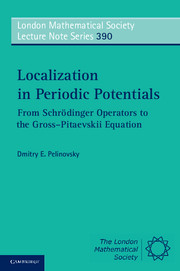Book contents
- Frontmatter
- Contents
- Preface
- 1 Formalism of the nonlinear Schrödinger equations
- 2 Justification of the nonlinear Schrödinger equations
- 3 Existence of localized modes in periodic potentials
- 4 Stability of localized modes
- 5 Traveling localized modes in lattices
- Appendix A Mathematical notation
- Appendix B Selected topics of applied analysis
- References
- Index
5 - Traveling localized modes in lattices
Published online by Cambridge University Press: 05 November 2011
- Frontmatter
- Contents
- Preface
- 1 Formalism of the nonlinear Schrödinger equations
- 2 Justification of the nonlinear Schrödinger equations
- 3 Existence of localized modes in periodic potentials
- 4 Stability of localized modes
- 5 Traveling localized modes in lattices
- Appendix A Mathematical notation
- Appendix B Selected topics of applied analysis
- References
- Index
Summary
Once we accept our limits, we go beyond them.
– Albert Einstein.There is a point where in the mystery of existence contradictions meet; where movement is not all movement and stillness is not all stillness; where the idea and the form, the within and the without, are united; where infinite becomes finite, yet not.
– Rabindranath Tagore.If we try titles like “mobility of breathers” or “moving solitons in lattices” on the Internet, the outcome will include a good hundred physics publications in the last twenty years. It is then surprising to hear from the author of this book that no traveling localized modes in lattices generally exist, except for some non-generic configurations of the discrete nonlinear Schrödinger equation in the space of one dimension. This chapter is written to elaborate this provocative point in relevant mathematical details.
It is true that traveling localized modes in nonlinear evolution equations with constant coefficients such as the nonlinear Schrödinger and nonlinear Dirac equations can often be found from stationary localized modes by means of the Lorentz transformation (Section 1.2.1). The periodic potentials break, however, the continuous translational invariance of the nonlinear evolution equations and destroy the existence of the Lorentz transformation.
To illustrate this point, we consider the cubic nonlinear Schrödinger equation,
which has the family of traveling solitons,
with arbitrary parameters ω < 0 and (c, s, θ) ∈ ℝ3.
- Type
- Chapter
- Information
- Localization in Periodic PotentialsFrom Schrödinger Operators to the Gross–Pitaevskii Equation, pp. 291 - 360Publisher: Cambridge University PressPrint publication year: 2011

